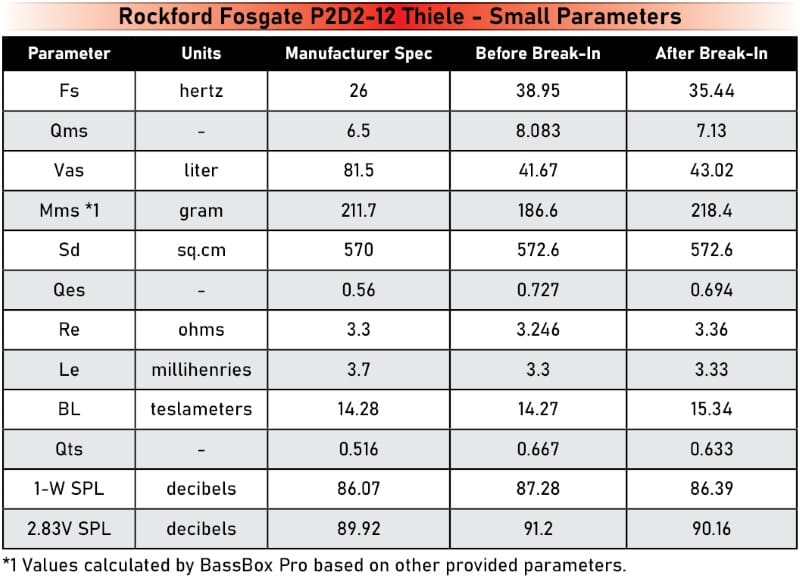When it comes to high-performance car audio subwoofers, the Rockford Fosgate brand should be at the top of the list. For over 50 years, these car audio fanatics have delivered audio upgrades designed with features and technologies that offer dramatic performance and longevity improvements over other brands. For this Test Drive Review, we have one of its 12-inch Punch Series P2D2-12 subwoofers in the lab for some analysis and evaluation. Let’s dig in!
Rockford Fosgate offers three series of products: Prime, Punch and Power. Prime subwoofers offer great performance and value. Punch subwoofers have higher power-handling limits and upgraded features that improve performance. The Power Series subwoofers pull out all the stops to deliver industry-leading products that few can match. The P2D2-12 fits in the middle of the Punch Series. Within that line are P1, P2 and P3 levels with different power handling and excursion capabilities. In short, Rockford Fosgate has a subwoofer for almost every application.
Design of the Rockford Fosgate P2D2-12 Subwoofer
The P2D2-12 is based on a heavy-gauge StampCast steep basket. The design looks like a cast aluminum design but without the significant cost. Four massive spokes extend up from the base of the basket to the mounting lip. The lip has four slots that Rockford Fosgate calls its FlexFit design. There are also four additional mounting holes between the slots. A closed-cell foam gasket comes pre-mounted to the underside of the mounting surface to ensure an airtight seal with the enclosure. A plastic insert on the top of the mounting surface gives the driver a clean and tidy appearance. A diamond-cut trim ring is included with the subwoofer. An optional mesh grille, the P2P3G-12, that fits between the basket and the trim ring is available.
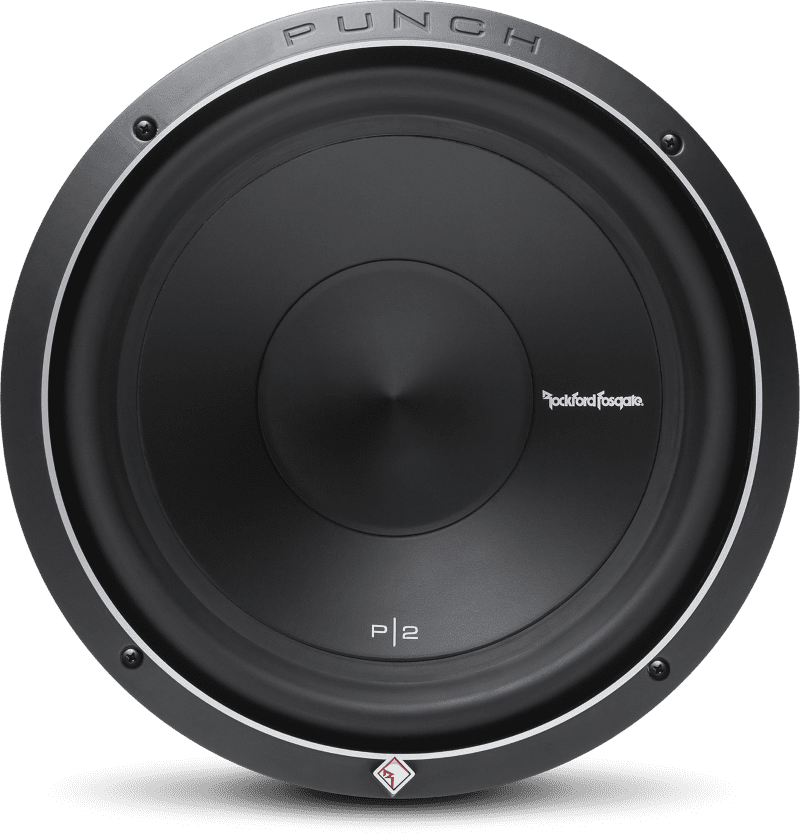
Four large cooling vents at the very base of the basket allow hot air to escape from the top of the motor structure. This feature improves power handling and reduces the chances of air pressure build-up under the spider from negatively affecting linearity.
Electrical connections are made via large spring-loaded push terminals on either side of the basket. The terminals will accept 10 AWG wiring. Each connection is housed in an injection-molded plastic mount so the wiring won’t come into contact with the metal basket. The wires extend downward from the connectors to keep them out of the way when the subwoofer is installed. That’s attention to detail!
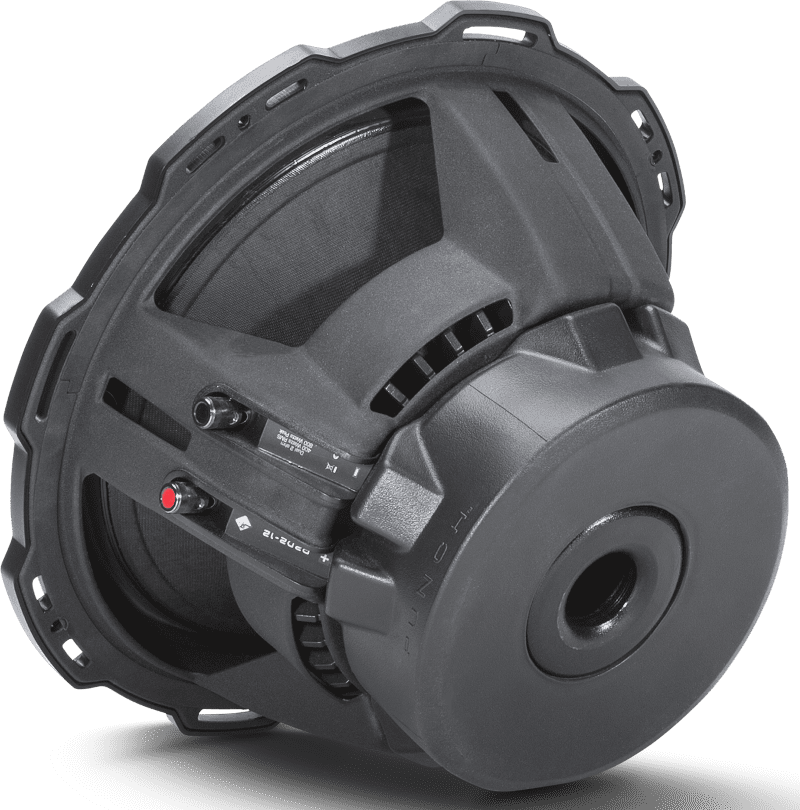
Punch Subwoofer Motor Assembly and Moving Parts
A double-stacked magnet assembly is affixed to the base of the basket. The magnets are covered with a custom PVC plastic trim piece that extends the basket’s shape. A large vent in the bumped T-Yoke provides additional cooling and pressure relief under the dust cap.
The P2D2-12 features an anodized aluminum voice coil former with a diameter of 2.25 inches. The voice coil winding has four layers, providing a 400-watt continuous power handling rating. All Rockford Fosgate speaker specifications comply with the ANSI/CTA-2031 standard, so you can trust the numbers explicitly. In the case of the continuous power handling ratings, Rockford Fosgate will have tested these (and all its drivers) and the rated level for at least eight hours. The driver uses 16 AWG tinsel leads sewn to the spider for efficient power transfer from the terminals to the voice coil winding.
I should have mentioned earlier that this is a dual voice coil subwoofer with a pair of 2-ohm coils. The driver can be wired to be a 1- or 4-ohm load for an amplifier. The P2D4-12 is the same driver but with dual 4-ohm coils. It can be wired as a 2- or 8-ohm driver.
The voice coil former is attached to the Kevlar fiber-reinforced cone using a spun-laced Nomex reinforcing collar. This connection is exposed to significant forces at high power levels. Keeping this connection solid is crucial to the longevity of the woofer.
Regarding suspension components, the P2D2-12 uses a pair of linear spiders at the base. On top, there’s a synthetic rubber surround that features the Vertical Attach Surround Technique geometry that optimizes cone area. The P2D2-12 has an effective surface area specification of 570 square centimeters. Popular competing products only have between 490 and 520 square centimeters. This simple design element makes the sub effectively much larger with the same mounting requirements. The enclosure must be slightly larger, but there’s a direct efficiency benefit.
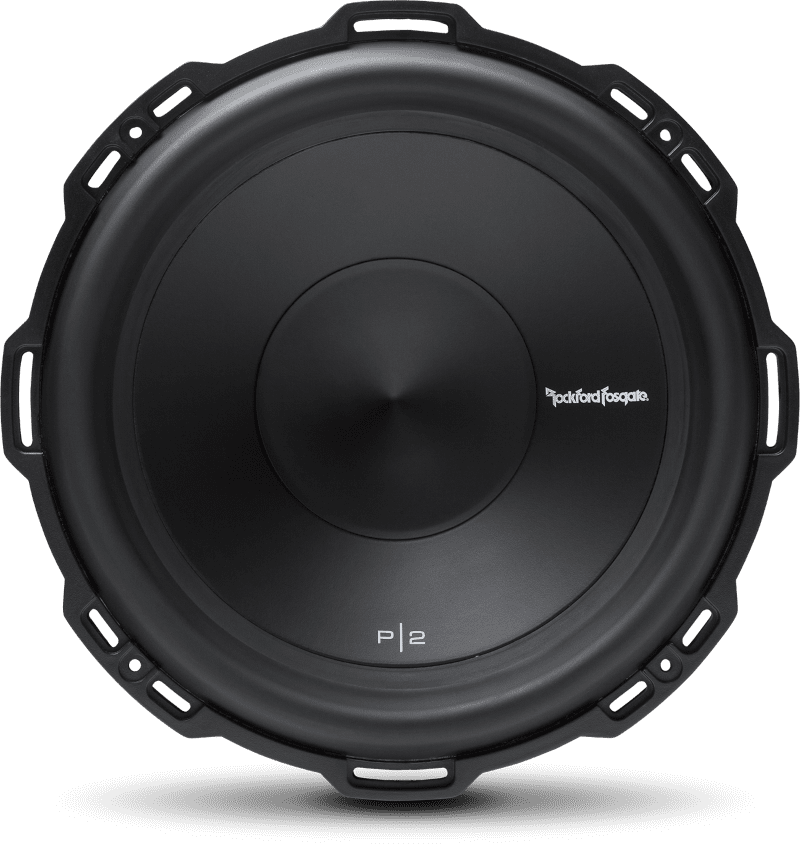
Punch P2 Subwoofer Thiele/Small Parameters
As usual, we started the review process by measuring the Thiele/Small parameter of the subwoofer straight out of the shipping carton. Next, we applied a low-frequency test signal to the driver for 10 hours to exercise the suspension. We repeated the parameter testing after letting the driver cool back to room temperature.
The two tests aim to determine whether the subwoofer parameters will change over the first little while of use. In this instance, the Fs dropped from almost 39 hertz to 35.4. The compliance increased from 41.7 to 43 liters, which isn’t significant. We’ve modeled the two sets of parameters and shown the predicted frequency response in a 2.0-cubic-foot sealed enclosure below. The numbers vary slightly from the factory specifications, but performance is within a decibel or two, so it’s not an issue. Rockford Fosgate publishes parameters based on post break-in periods that have been normalized and is known to make improvements to its products over their lifespan.
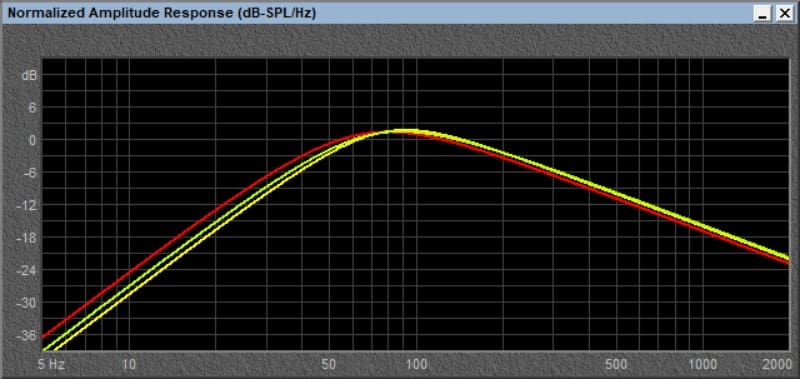
The red trace in the above graph represents the as-published specifications of the subwoofer. The yellow trace is the predicted response based on the parameters measured before the break-in process. The green trace is the predicted response after the break-in. You can see that low-frequency output increases as the suspension becomes more compliant. You’ll want to play these subs well and hard to get them broken in quickly for maximum enjoyment.
Acoustic Suspension Enclosure Simulations
Now that we have a set of parameters, let’s look at the predicted output of the P2D2-12 in a few different enclosures. We’ll start with the suggested enclosures from the Box Advisor on the Rockford Fosgate website. For an acoustic suspension (sealed) enclosure, the site suggests an enclosure volume of 1.02 cubic feet. Based on our measured parameters, this design would yield an F3 of 49.34 hertz and a Qtc of 0.875. When driven with 400 watts of power, cone excursion doesn’t exceed 7 millimeters at any frequency. If space is a concern, this is an excellent choice.
We often look at the suggested High Fidelity enclosure that BassBox Pro suggests. For this driver, that’s 2.7 cubic feet. The benefit is a closer-to-ideal Qtc of 0.707 and a lower F3 of 44.4 hertz. Excursion remains under the Xmax specification. However, the massive size likely isn’t worth it. You could add 1.5 pounds of damping to the 1.0-cubic-foot enclosure and get similar results.
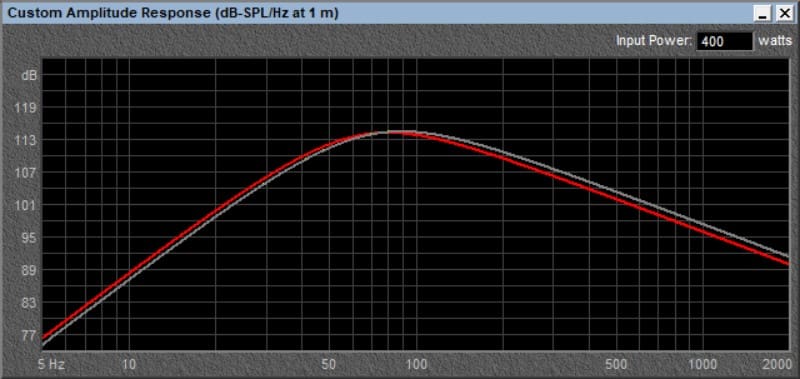
Bass Reflex Enclosure Simulations
Regarding a bass reflex enclosure, the Box Advisor suggests a design with a volume of 1.79 cubic feet with a vent tuned to 35 hertz. If there were a “standard” for a 12-inch subwoofer ported enclosure, this would be it. Our simulations predict an F3 frequency of 30.54 hertz. The efficiency gain at 35 hertz over the acoustic suspension enclosure is an impressive 7.3 dB SPL. Further, it’s louder everywhere from 18.5 hertz to beyond any reasonable crossover frequency. Excursion-based power handling is fine down to 25 hertz. You’ll want to run an infrasonic filter at or near that frequency to keep the driver safe. Given the options, we always suggest the bass reflex design if the space is available.
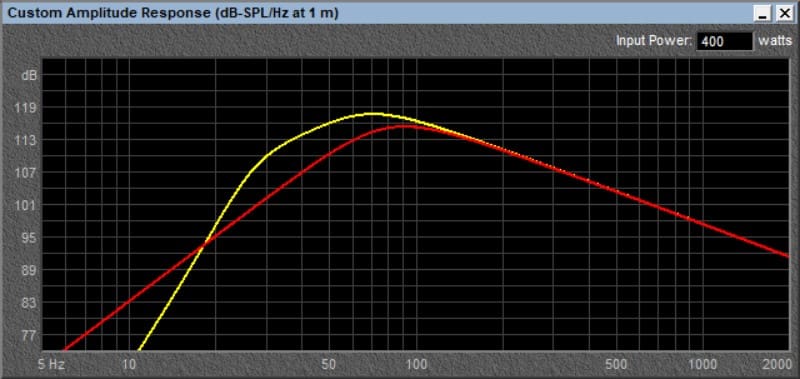
Listening Evaluation
I designed a bass reflex enclosure for the P2D2-12. It has a net volume of 1.43 cubic feet and is tuned to 35 hertz. I set the subwoofer up in my listening room and connected it to a 1,000-watt amplifier. The source unit handled the crossover, and as always, I checked that the output level and polarity settings matched my target curve.
The listening evaluation started with “You Should See Me in a Crown” by Billie Eilish. The P2D2-12 provided a good balance of boom and rumble. It didn’t do anything that would draw unwanted attention to itself. The sub has a good punch, pardon the pun. It’s a touch boomier than what would be considered an audiophile-grade subwoofer. However, that’s precisely its intention. The design options gain some efficiency and output emphasis in the middle bass range to make your music thump. I should be clear that the sub is in no way sloppy.
Next up was Infected Mushroom with “Eat it Raw.” The sub wasn’t what I’d call authoritative at the deepest notes, but that’s because of the enclosure design. With another 0.4 cubic foot and tuning down around 31 hertz, the boom would be traded for more extension. Nevertheless, I could feel the lowest notes clearly in the listening position, and the woofer never sounded stressed.
Last up was “Torus” by DJ and record producer Sub Focus. The song’s intro doesn’t have a lot of deep bass. With a 45-hertz note and some harmonics at the one-minute mark, things get rolling. The P2D2-12 was clear and solid. Things drop good and deep at the three-minute mark, with bass information down to around 22 hertz. This is masked somewhat by loud 43-hertz information, but it still fills the room with well-defined pressure waves that shake the couch. This track is a lot of fun, and the Rockford Fosgate sub did a great job handling the lowest notes.
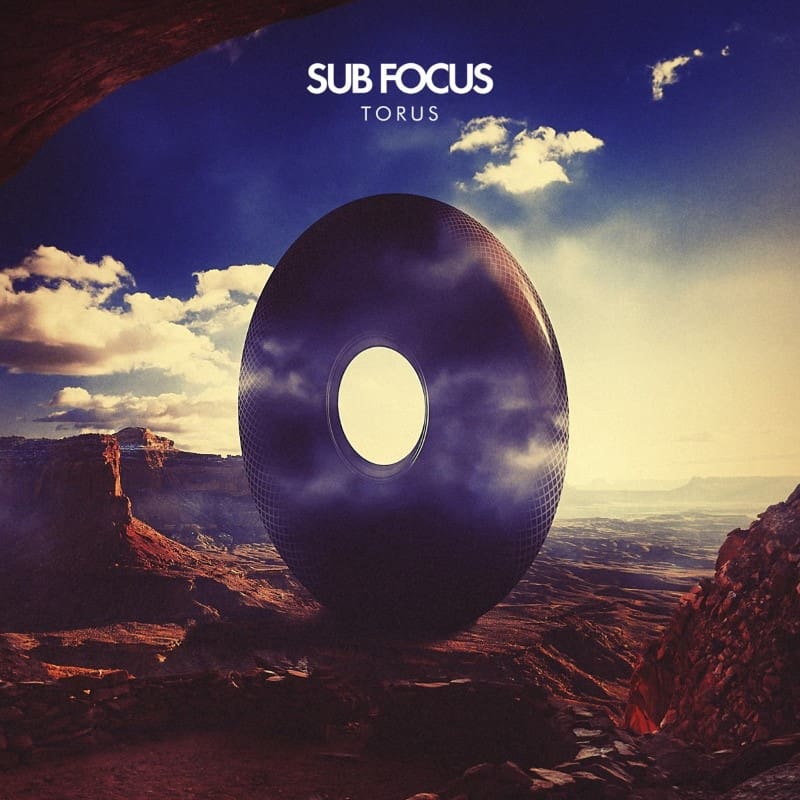
Conclusions on the Rockford Fosgate P2D2-12 Subwoofer
The challenge in quantifying value is evaluating performance versus cost. The P2D2-12 doesn’t complain when pushed hard, moves lots of air, and has a nice bump that adds to its efficiency. Attention to detail like that found in the mounting gasket, custom terminal mounts, a cool trim ring and excellent thermal management features put it well beyond what others offer at its price point. If you’re looking for a rock-solid, reliable mid-level subwoofer, I recommend that you visit an authorized Rockford Fosgate retailer to check this sub out.
You can learn more about the entire series of Punch subwoofers on the Rockford Fosgate website. Also, be sure to follow our friends from Tempe on Facebook, Instagram and of course, YouTube. The videos they produce are absolutely amazing!

